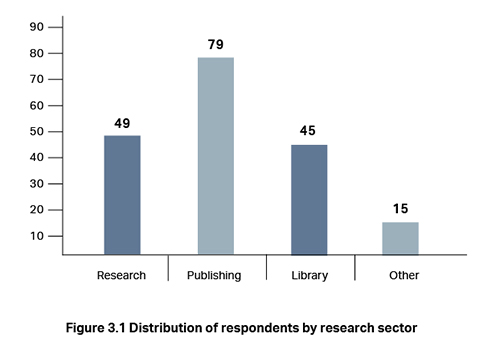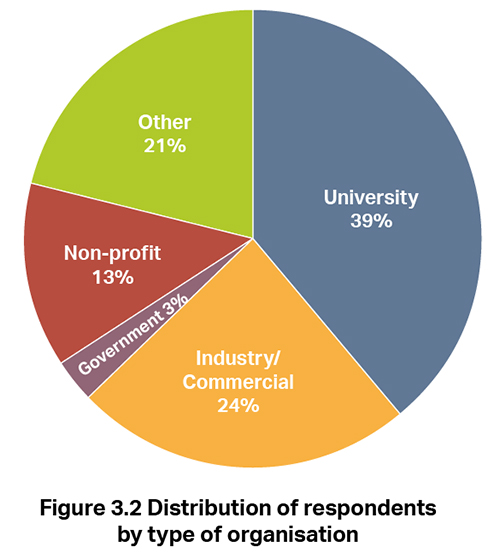3. Methodology
3.1 Survey design
The questionnaire was broadly split into two parts: open-ended questions about perceived challenges, and a request for respondents to rate issues identified in the literature. The full questionnaire can be seen in Appendix 1.
3.1.1 Open-ended questions
The open-ended questions provided at the beginning of the survey were designed to solicit insights into perceived challenges affecting each of the three sectors without influencing those perceptions.
Respondents were asked what were the biggest challenges faced by each of the three sectors, and how the other two sectors could help. For example:
- What do you consider the biggest single scholarly publishing challenge facing the Research sector?
- How could the publishing sector help the research sector?
- How could the library sector help the research sector?
Respondents were not only asked about the challenges facing the sector they perceived themselves to be working in, but also the other two sectors.
3.1.2 Rating pre-identified topics
In the second part of the questionnaire respondents were also asked to rate a set of challenges identified from a search of the literature (ACRL Research Planning and Review Committee, 2014; ACRL Research Planning and Review Committee, 2016; Anderson, 2013; Carpenter, 2017; Cheng, 2016; Folan & Grace, 2017; Gillingham, 2013; Meadows, 2013; NMC, 2017; Royal Society, 2015; Sullivan, 2017; Ware & Mabe, 2015). Each issue was accompanied by an explicit definition:
- Skills and training – Ensuring those involved in the scholarly publishing research cycle have the skills and training necessary for the evolving scholarly publishing ecosystem;
- Plagiarism – The practice of people passing other people’s work or ideas off as their own;
- Piracy – The illegal copying, distribution, or use of scholarly output that results in an infringement of intellectual property rights;
- Discoverability – Ensuring researchers discover the resources they need;
- Accessibility – Ensuring that researchers can access the resources that they need in the way that they need them;
- Trust and validation – Sufficient mechanisms are in place to ensure the quality of scholarly outputs;
- Measuring impact - Ensuring the impact of resources and scholarly outputs can be demonstrated;
- Data and non-traditional scholarly output support – Ensuring support in the research cycle for the publishing, discovery, and access to data and non-traditional scholarly outputs;
- Open access and licensing – An appropriate set of open access and licensing models to support an innovative scholarly research ecosystem;
- Institutional and subject repositories – Ensuring the development and long-term support of a robust system of institutional and subject repositories;
- Personalisation – The provision of personalised services to individual researchers;
- Metadata and standards – Support and development of metadata and other standards for the scholarly publishing research cycle;
- Privacy and data protection – Protecting individuals’ right to privacy and ensuring compliance with data protection legislation;
- Policymakers’ scholarly publishing policies – Government and other research funders’ scholarly publishing policies that support an innovative scholarly research ecosystem.
Respondents were asked to rate both how important the issues were perceived to be, and how big a challenge the issues were perceived to be, on a scale of 0-10. This was designed to reduce ambiguity about the meaning of the terms, and to enable the report to focus on those items that were not only important, but also seen as a challenge to be overcome.
3.1.3 Respondents
An online survey was shared with Research Information subscribers, shared on the Research Information website, and on social media. Research Information is a professional magazine whose readership spans the research, publishing, and library sectors.
There were 188 respondents with valid responses, 79 stated they worked within the publishing sector, 39 in the research sector, and 45 in the library sector. Of the 122 that stated the country in which they primarily worked, 51 worked in the UK and 25 in the USA; no other country was represented by more than five respondents. Most respondents came from either university or commercial sectors.

3.2 In-depth interviews
Alongside the questionnaire 12 interviews took place: four researchers, four publishers, and four library/information professionals. These were designed to provide broader context and insights to the survey results, where individual responses were expected to be shorter.
The contributions of the interviewees are included as separate panels.







